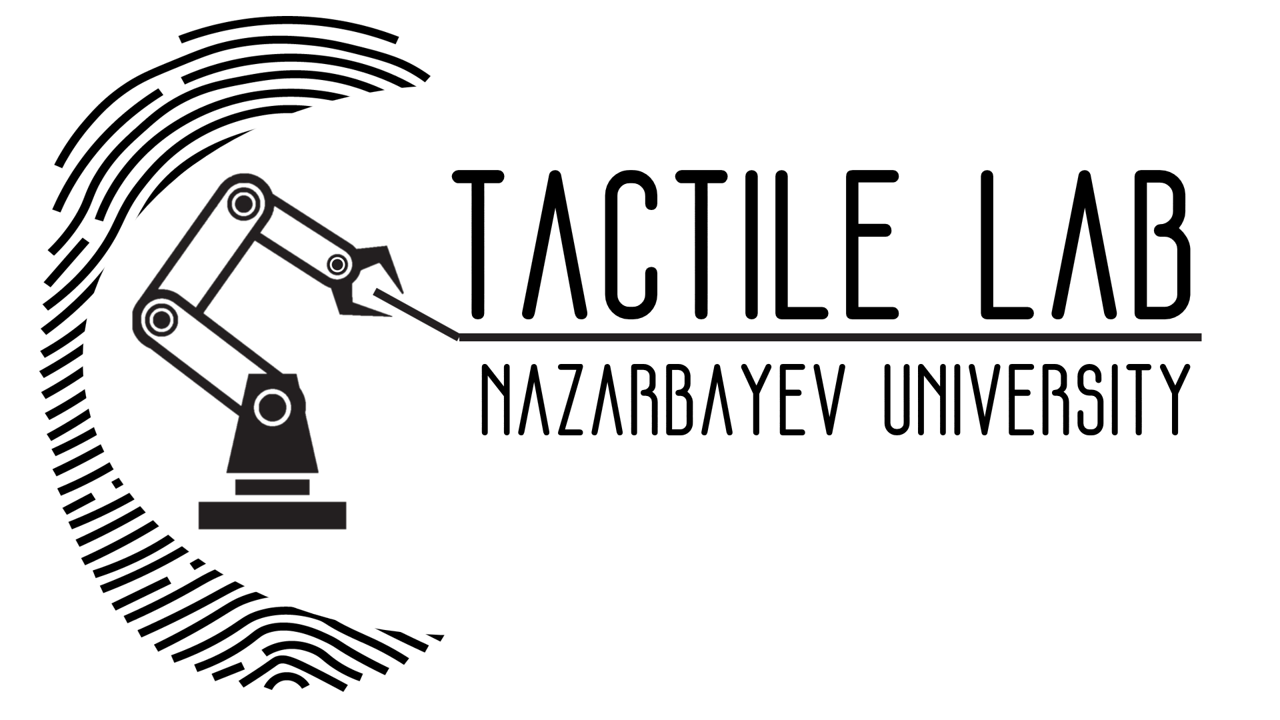Welcome to the Tactile Robotics Laboratory
We are located in the capital of Kazakhstan and develop tactile sensors to integrate them with robots for object manipulation in human-robot interaction. We also design of haptic interfaces to study tactile human perception.
Exploring the Future of Tactile Robotics: A Journey through Our Laboratory
Projects

Tactile Servoing
Control – oriented research direction that tackles general problems of steering a physical contact between a robot arm and the environment via tactile sensing arrays. Firstly, it is important to understand what to control and how to derive these “what to control”. We describe tactile features representing this “what” and robot arm control algorithm in our paper (Touch driven controller and tactile features for physical interactions, Robotics and Autonomous Systems, 2020). PhD Thesis, 2017. Best Thesis Award (2nd place, France)
Optical Tactile Sensors
Fabrication – oriented direction that focuses on a general use of transparent silicone and image cameras connected via plastic optical fibers in detecting physical contacts between the robot end-effectors and the environment. First approach used reflection, which was created using the magnetron spattering method, Color-Coded tactile sensor ICRA2019 and the second method was based on detecting changes of color due to mechanical shear and strain Shear and Protrusion Sensor (RA-L with ICRA2020)
https://youtu.be/7wsURXJrq7U
https://youtu.be/7wsURXJrq7U
PhotoElasticFinger: Robot Tactile Fingertip Based on Photoelastic Effect
The sensor measures the force based on the PhotoElastic effect observed in the silicone matter. The polarized light within the silicone rubber is subjected to the phase-shift when the silicone is pressed. Force estimated is proportional to the light received by the camera. This paper has been published in Sensors as part of the Special Issue Advances in Bio-Inspired Skin-Like Sensor Technologies, 2022.
https://youtu.be/s9dM9OUDbQg
https://youtu.be/s9dM9OUDbQg

Magnetic field-based tactile sensors
Fabrication – oriented direction that focuses on investigating methods of using of magnets and magnetic field sensors as tactile sensing devices. The use of the Hall-effect sensor that detectects the distance to the magnet attached onto a spring is described in IROS 2018 conference publication: Magnetic Tactile Sensor.

Vibro-tactile slip, slide, texture detection
Deep Vibro-Tactile Slip Detection and Texture Identification
The state-of-the-art LSTM, FFN, CNN architectures were applied to detect slippage and identify various textures – journal paper (Massalim et al, mdpi sensors, 2020).
Tactile Sensor for Contact Detection and Force Sensing via Vibrations
The main idea behind the project is the phenomenon of change in vibration propagation patterns depending on the grip properties. The sensor is used for detecting whether the contact has happened or not. This paper has been published in Sensors as part of the Special Issue Advances in Bio-Inspired Skin-Like Sensor Technologies, 2022.
Deep Vibro-Tactile Slip Detection and Texture Identification
The state-of-the-art LSTM, FFN, CNN architectures were applied to detect slippage and identify various textures – journal paper (Massalim et al, mdpi sensors, 2020).
The state-of-the-art LSTM, FFN, CNN architectures were applied to detect slippage and identify various textures – journal paper (Massalim et al, mdpi sensors, 2020).
Tactile Sensor for Contact Detection and Force Sensing via Vibrations
The main idea behind the project is the phenomenon of change in vibration propagation patterns depending on the grip properties. The sensor is used for detecting whether the contact has happened or not. This paper has been published in Sensors as part of the Special Issue Advances in Bio-Inspired Skin-Like Sensor Technologies, 2022.
Deep Vibro-Tactile Slip Detection and Texture Identification
The state-of-the-art LSTM, FFN, CNN architectures were applied to detect slippage and identify various textures – journal paper (Massalim et al, mdpi sensors, 2020).

Deformable Object Recognition
Soft objects are increasing their attention in manipulation – oriented papers. We developed a pipeline to detect soft and rigid objects using a tactile sensing array – conference IEEE SII2019, Paris.
Granular Object Recognition
Soft objects can be crunchy inside. In this connection, we can detect various soft objects based on their not only softness but also mechanical vibrations. We applied machine learning methods to detect a foreign body in a soft object (Syrymova et al, AIM2020, Boston).
Granular Object Recognition
Soft objects can be crunchy inside. In this connection, we can detect various soft objects based on their not only softness but also mechanical vibrations. We applied machine learning methods to detect a foreign body in a soft object (Syrymova et al, AIM2020, Boston).
Haptic Illusion
Haptics – oriented research direction, in which we aim in developing new combinations of haptic and visual illusions. We show how pseudoo- and haptic illusions can be used to trick a human brain in perceiving soft objects with different stiffness.
RA-L + ICRA2020, Paris
https://youtu.be/4savtLCym4E
https://youtu.be/NmQ4N_Cj838
RA-L + ICRA2020, Paris
https://youtu.be/4savtLCym4E
https://youtu.be/NmQ4N_Cj838
Negative Stiffness Structure
Structures design – related research direction that investigates how artificial mezo-structures with negative stiffness properties can be used as active tactile surfaces.
Analytical modelling of a Negative Stiffness Honeycomb is described in IOP Smart Materials and Structures paper.
https://youtu.be/ByPX0TAFekM
Linear Negative Stiffness Honeycomb Actuator with Integrated Force Sensing
Application of Negative Stiffness Structures in actuators is described in our AIM2020, Boston conference paper by Galimzhanov et al.
Analytical modelling of a Negative Stiffness Honeycomb is described in IOP Smart Materials and Structures paper.
https://youtu.be/ByPX0TAFekM
Linear Negative Stiffness Honeycomb Actuator with Integrated Force Sensing
Application of Negative Stiffness Structures in actuators is described in our AIM2020, Boston conference paper by Galimzhanov et al.

Human-Robot Handover with Prior-to-Past Soft/Rigid Object Classification via Tactile Glove
Robot control design for HRI. This research direction investigates how Robot arms can be used as collaborators.
This work is done in collaboration with Matteo Rubagotti’s RCLlab
This work is done in collaboration with Matteo Rubagotti’s RCLlab
Augmented Reality and Haptic Teleoperation
This paper was submitted to IEEE TRO 2023 (initially it was submitted to IEEE RA-L in 2021)
Optical Tactile Sensors
Fabrication – oriented direction that focuses on a general use of transparent silicone and image cameras connected via plastic optical fibers in detecting physical contacts between the robot end-effectors and the environment. First approach used reflection, which was created using the magnetron spattering method, Color-Coded tactile sensor ICRA2019 and the second method was based on detecting changes of color due to mechanical shear and strain Shear and Protrusion Sensor (RA-L with ICRA2020)
Magnetic field-based tactile sensors
Fabrication – oriented direction that focuses on investigating methods of using of magnets and magnetic field sensors as tactile sensing devices. The use of the Hall-effect sensor that detectects the distance to the magnet attached onto a spring is described in IROS 2018 conference publication: Magnetic Tactile Sensor.
Researchers: Zhanat Kappassov; Daulet Baimukashev; Olzhas Adiyatov; Shyngys Salakchinov; Yerzhan Massalin; Huseyin Atakan Varol.
Researchers: Zhanat Kappassov; Daulet Baimukashev; Olzhas Adiyatov; Shyngys Salakchinov; Yerzhan Massalin; Huseyin Atakan Varol.



